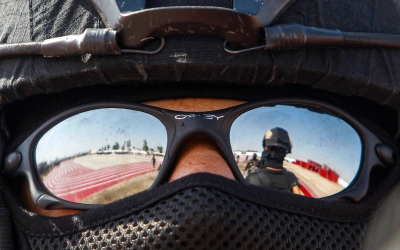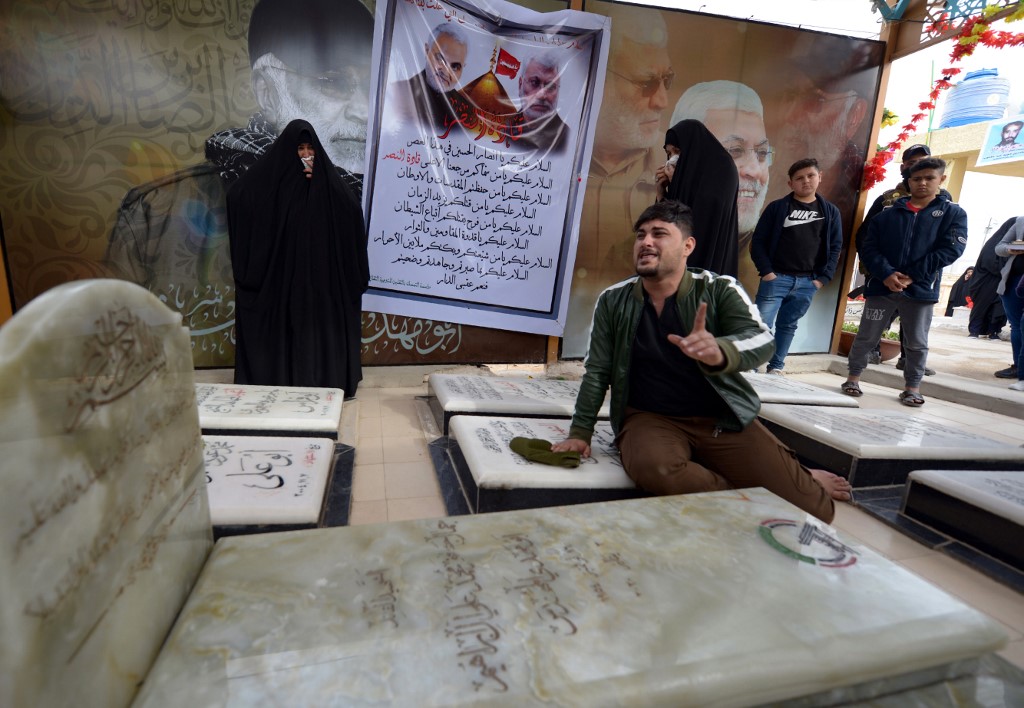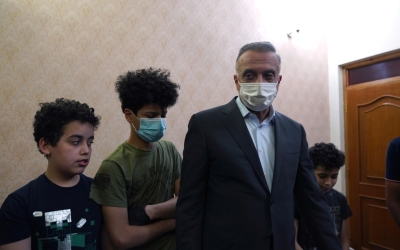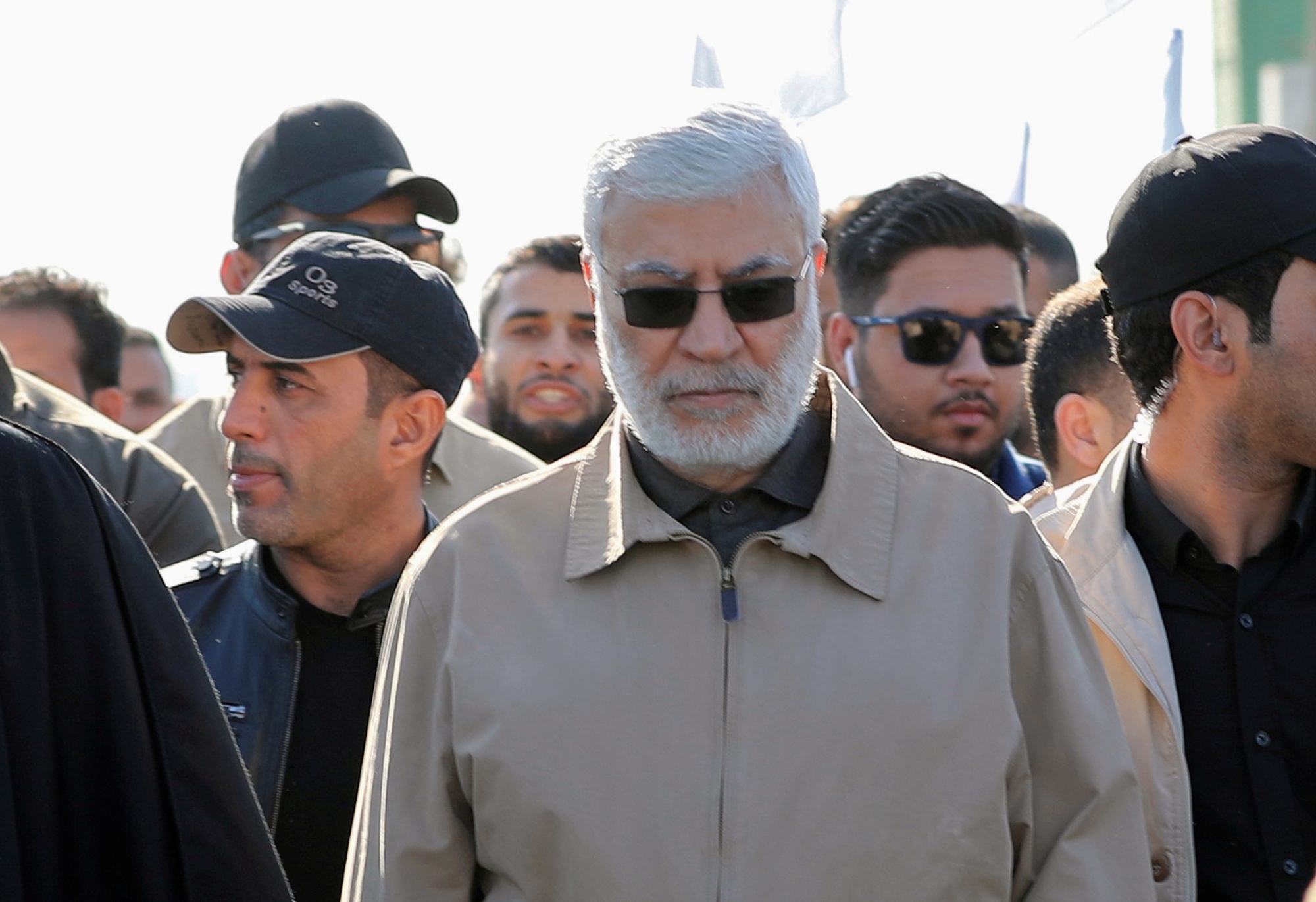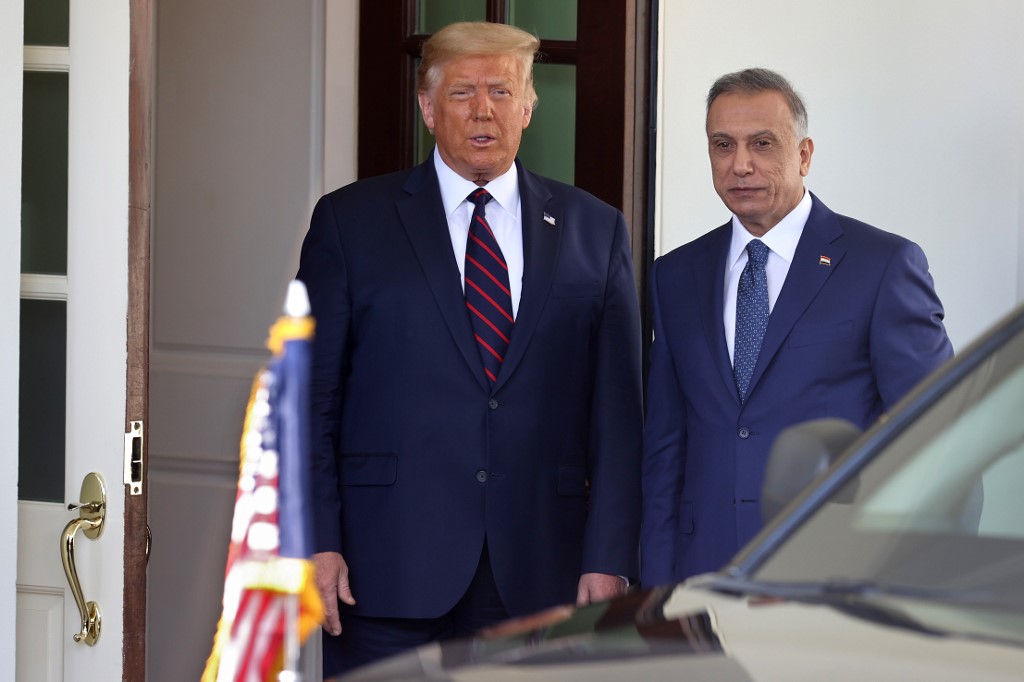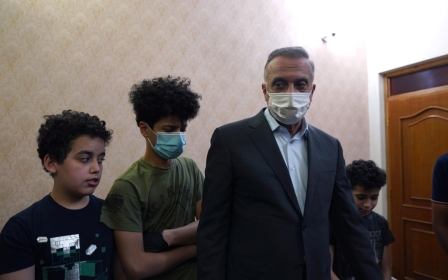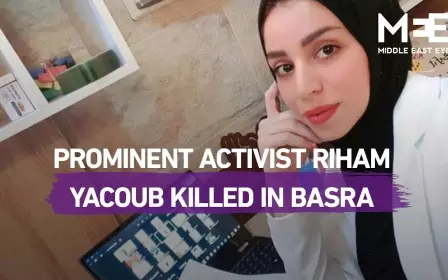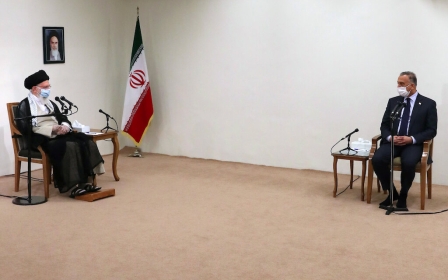REVEALED: The true story behind Kataeb Hezbollah and Kadhimi's conflict

As Haider al-Abadi's military helicopters grew smaller in the sky and their roar and whipped-up wind diminished, Tal Afar air base began to regain its sense of relative calm.
Abadi, then prime minister, had travelled to the northern Iraqi base on 24 November 2016 to confer with military commanders overseeing the operation to liberate Mosul from the Islamic State (IS) group.
Inside the base, retaken from IS a few days before, were Shia-dominated paramilitary forces. So too were a number of commanders of Iran-backed armed factions.
Hadi al-Amiri, commander of Badr Organisation, the oldest and largest Shia armed faction, hung back after Abadi left.
So too did Shebel al-Zaidi, commander of Kataib al-Imam Ali, Karim al-Khaqani, the commander of Imam Ali Combat Division, and a number of commanders operating under the Popular Mobilisation Authority (PMA), the grouping of predominantly Shia armed factions united to fight IS.
New MEE newsletter: Jerusalem Dispatch
Sign up to get the latest insights and analysis on Israel-Palestine, alongside Turkey Unpacked and other MEE newsletters
They convened in the tent of Abu Mahdi al-Muhandis, deputy head of the PMA and co-founder of Iran-backed Shia faction Kataeb Hezbollah, who was leading the field operations against IS at the time.
Suddenly, the moment of calm turned into one of chaos, as a missile crashed into the earth two metres away from Muhandis's tent, which collapsed onto the heads of several powerful Shia commanders.
Two of Amiri's bodyguards were killed, with military sources telling Middle East Eye that Zaidi and Khaqani were wounded, along with Abu Husam al-Sahlani, the head of Badr Organisation's operations, and Abu Zahraa al-Timimi, a Kataeb Hezbollah commander.
Though dramatic, the incident did not seem to cause any political or security furore, and the Joint Operations Command of the international coalition fighting IS hardly paid any attention to the incident, saying the militant group had targeted Abadi.
The area "was still a security hotspot, and the large number of helicopters that were hovering around it drew attention to the presence of Abadi there", a former Iraqi member of the coalition's media office told MEE.
Less than 36 hours later, Muhandis and Amiri issued a statement saying that preliminary information revealed by investigations indicated that "the missile was not fired by IS terrorist groups, but was laser-guided and launched by a drone".
"The coalition forces should provide an explanation for what happened, as they are responsible for securing the airspace in the area of military operations west of Mosul," said the statement issued by the PMA.
Yet little further noise was made about the incident, with the majority of commanders and leaders moving swiftly on as the battle for Mosul intensified.
Muhandis could not move on. The Kataeb Hezbollah co-founder considered it a "warning signal, indicating that there is a traitor within the narrow circle close to him", a current prominent PMA commander who was close to Muhandis told MEE.
The man known as "the engineer" did not raise his suspicions publicly, but he and his Iranian allies "followed all possible leads to reveal the identity of that traitor", said the commander, who remained a confidant of Muhandis up until his death at the beginning of this year.
Accusations against Kadhimi
Today, Abadi is no longer prime minister. IS has been territorially defeated and Muhandis lost his life in January in the fireball that killed Iranian general Qassem Soleimani.
Though it is thought that the US strike on Baghdad airport was primarily intended for Soleimani alone, and Muhandis was simply in the wrong place at the wrong time, Kataeb Hezbollah has intimated that it holds the man who headed Iraqi intelligence - Mustafa al-Kadhimi - responsible for its co-founder's death.
Kadhimi, the paramilitary and its allies have said, shared information about Muhandis's whereabouts with Washington and invited his demise.
Now elevated to prime minister through a tacit agreement between Iran, the US and certain Iraqi political forces, Kadhimi has been relentlessly attacked by Kataeb Hezbollah-linked media and seen rockets rain down on key American and Iraqi targets in an apparent bid to destabilise his premiership.
Last month, Yazin al-Jubouri, former political adviser to Muhandis, took the accusations further, causing a storm as he claimed in a TV interview that Kadhimi was involved in plotting the Kataeb Hezbollah co-founder's death years ago.
Jubouri later told MEE that Muhandis often accused Kadhimi of planning his assassination.
"Kadhimi himself discussed these accusations with me three times in three separate interviews, in an attempt to convince me that the information provided to Muhandis was incorrect, so that I do my part to convince Muhandis of what Kadhimi says," Jubouri told MEE.
"I didn't ask the two men for the details, so I don't know where, how and when [the plot was alleged to have happened], but this [the discussions] happened at some point in 2017," he added.
"I am quoting what I heard from Muhandis and Kadhimi, but I don't know if this actually happened or not."
Jubouri told MEE that Kadhimi tried several times to meet Muhandis to "clear his reputation", but the latter routinely refused. Eventually, Kadhimi was received in Muhandis's Baghdad home, and while he attempted to lay out the reasons his intelligence agency was unable to carry out such an operation, the Kataeb Hezbollah co-founder "handed him a list of the names of the officers in charge of carrying out the assassination", Jubouri said.
Ali Fadel, one of Muhandis's personal companions for the last three years, refused to comment to MEE on details relating to his former boss for "security reasons". But he nonetheless described Jubouri's allegations about Kadhimi as "inaccurate".
Two close friends of Muhandis, one a current prominent PMA commander, the other a commander of an armed faction operating under the PMA's umbrella, said they had never heard him talk about the Iraqi intelligence service or Kadhimi planning to assassinate him.
The two men, who spoke on condition of anonymity, confirmed however that the tension between the two men had reached its peak sometime in 2017, after Muhandis found out that the intelligence service had been monitoring him and listening to his calls.
"Actually, Kadhimi asked to meet Muhandis to dispel the tension between them. He invited him to have lunch at his home inside the Green Zone," the armed faction commander said.
"Information was constantly reaching Muhandis indicating that the Iraqi intelligence was working against him, so he was very angry. That is why he agreed to meet Kadhimi when he asked to see him."
The commander confirmed the meeting between them took place.
"My understanding was that Muhandis was upset because the intelligence agency was monitoring his movements, wiretapping his phones and communicating information to the interested parties, but the matter did not come to the prospect of assassinating him," he said.
Incitement campaign
Three days after Jubouri's 13 July TV interview, several news sites linked to Kataeb Hezbollah published a list of seven names they said were the intelligence officers who were assigned by Kadhimi to assassinate Muhandis.
A few hours later, a large-scale incitement campaign was launched against the officers, in which most of the media affiliated with the Iranian-backed armed factions participated.
Although these channels and websites re-published the names and devoted many hours of airtime to discussing the accusations against Kadhimi and the Iraqi intelligence service, none provided any details or evidence to support the allegations.
Jubouri told MEE that his information indicates the involvement of one of these officers, while he does not know anything about the rest.
According to several security sources contacted by MEE, some of the named are senior intelligence officers, who are now under heavy protection, but nothing proves their involvement in the alleged assassination attempt.
MEE contacted the director of Kadhimi's media office and sent written requests to three of his advisers, in addition to his former office manager when he was director of intelligence, to comment on Jubouri's and Kataeb Hezbollah's claims, but none of them responded.
Selfie with Nasrallah
Despite Kataeb Hezbollah's ferocious attacks on Kadhimi, many in the armed faction see the threats to Muhandis's life as coming instead from a very different source.
In November 2015, Akram al-Kaabi, commander of the Harakat Hezbollah al-Nujabaa paramilitary, visited Hassan Nasrallah, leader of the Lebanese Hezbollah, at his residence in Beirut's southern suburbs.
Kaabi was accompanied by a young Shia politician whose name had risen as one of "the best mediators and coordinators of relations between Shia forces", said a prominent commander of al-Nujabaa, which is a splinter group of the powerful Iranian-backed Shiite paramilitary Asaib Ahl al-Haq.
The young politician, who will be referred to as Mussaib for security and legal reasons, was a leader of one of Iraq's Shia political parties.
But he was not widely known until the end of 2012, when he was appointed to a senior government position in an institution associated with the presidency of the cabinet.
According to a number of officials, politicians and PMA commanders spoken to by MEE, Mussaib built a network of relationships with a number of corrupt officials and politicians who were part of the retinue of Nouri al-Maliki, during the prime minister's second term of office.
With them, the sources said, Mussaib concluded many shady deals and facilitated their seizure of hundreds of state properties worth hundreds of billions of dollars.
Mussaib's natural ability to market himself as everyone's friend, and his government position providing him access to state-owned real estate, enormous financial resources and an annual budget, facilitated his meteoric rise.
In less than three years, Mussaib became close to the majority of Iraq's most-powerful Shia leaders, including Maliki, Amiri and Muqtada al-Sadr, the powerful cleric who has millions of followers and controls a large parliamentary bloc and armed faction.
"He [Mussaib] developed relations with those at the top of power, so closed doors were opened for him," a prominent Shia politician close to Maliki told MEE on condition of anonymity.
"That is why we see him playing an even greater political role than the party he came from.
"His eminent presence with Maliki, Amiri and Sadr always surprised me, so I thought that the man might be recommended by Iran."
Mussaib had become close to the head of al-Nujabaa and used to accompany Kaabi on most of his trips, two of the faction's leaders told MEE. Until the trip to Beirut, that is.
Nasrallah welcomed them. The three men talked about the latest developments in the battles waged by the Iranian-backed Shia factions against IS in Syria and Iraq, where al-Nujaba was fighting.
The meeting proceeded smoothly and without disturbance, until everyone was shocked when Mussaib took out a smartphone from his pocket and asked to take a picture with Nasrallah.
"That behaviour was very embarrassing for Kaabi. It was a security breach at the highest levels," one of al-Nujabaa's commanders, who is close to Kaabi, said.
"Everyone knows the security procedures that are followed when meeting Nasrallah. Neither phones nor any type of technology are allowed to enter with the visitor. Kaabi was responsible for that breach, because Nasrallah received Mussaib on his recommendation."
Nasrallah immediately ended the meeting and asked the two men to leave.
Kaabi did not speak out about what happened, as "it was evidence of his weakness and the absence of his sense of security", but he quarrelled with Mussaib and "took him out of the circle of people he trusted", the commander said.
Powers of persuasion
Months later, and for some undeclared reason, Muhandis responded to Mussaib's attempts to be close to him and join his ranks of advisers. The godfather of most of the Shia paramilitaries linked to Iran assigned Mussaib to work on one of the most difficult issues Muhandis faced: dismantling the disputes between the leaders of the armed Shia factions and reconciling them, three PMA commanders told MEE.
Not only that, but he was assigned to work on reconciling the leaders of the Iranian-backed factions with the leaders of the groups associated with Iraq's Grand Ayatollah Ali al-Sistani.
Using his now-renowned powers of charm and persuasion, Mussaib succeeded in gathering most of the disputing leaders in one place. Muhandis, Amiri, Qais al-Khazali and Kaabi joined Sadr for lunch at the cleric's Najaf home in October 2016, as a goodwill gesture.
Though Mussaib achieved some sort of success in gathering the men together in one room and projecting an image of unity, he fell short of arranging the same sort of meeting with leaders of factions linked to Sistani.
"The man [Mussaib] was adopting the principle of the ends justifying the means, and his network of relationships was and still is dubious, so we have not trusted him," a senior PMA commander linked to Sistani told MEE.
"He invited us to have lunch at his house with a number of other leaders, but we refused the invitation," he continued.
"And we sent a message to Muhandis and Amiri that Mussaib is not authorised to speak on our behalf and what he told you about his ability to influence our decisions is an illusion."
Enemy in the ranks
Mussaib, as one of Muhandis's advisers, was present at the November 2016 meeting at the Tal Afar air base. One of his bodyguards was wounded in the rocket attack.
Although Muhandis himself told a number of PMA commanders and Jubouri that the missile was fired from a Turkish drone, and that Ankara was behind the attack, others have their own suspicions.
Turkish officials have declined to comment on the issue. However, sources close to Ankara said that Turkey didn't have armed drones in 2016 to conduct such operations. "This is likely to have been conducted by Israel or the US. Turkey didn't have such capabilities back then," a source with knowledge told MEE.
Al-Nujabaa and Kataeb Hezbollah instead accuse Mussaib of being involved in the attack.
'Muhandis discovered that he [Mussaib] was a hypocrite and passed on information to several parties'
- PMA commander
Al-Nujabaa's commanders say the Iranians monitor the phones of all Shia leaders, including Muhandis, "as part of their strategic security," and that reviewing the call records of all the leaders who were inside the tent before and after the incident has revealed that someone inside the tent had sent the location coordinates to someone outside.
To their surprise, according to two senior leaders of Kataeb Hezbollah and al-Nujabaa, "Mussaib was the owner of the phone that sent these coordinates".
None of the commanders close to Muhandis confirmed this account, but they told MEE that the relationship between Muhandis and Mussaib was "very bad" after that incident.
"Muhandis discovered that he [Mussaib] was a hypocrite and passed on information to several parties," a PMA commander close to the Kataeb Hezbollah co-founder told MEE.
Al-Nujabaa leaders say Mussaib had in fact been recruited by Iraqi intelligence, and was close to the agency's former head, Lieutenant General Zuhair al-Gharbawi, who was replaced by Kadhimi in July 2016.
They claim that he deals with the Americans and had provided them with information about Muhandis and the leaders of the factions for years before Muhandis's killing.
Meanwhile, Kataeb Hezbollah is "still investigating the nature of Mussaib's relationship with the Iraqi intelligence service," but says that its information confirms his relationship and cooperation with the Americans, one of the faction's commanders told MEE.
"For us, the matter is still under investigation regarding Mussaib's relationship with intelligence, and the person assigned to investigate this file met Kaabi a few days ago to hear what he had," he said.
"As for al-Nujabaa, this man is dead."
A string of assassination attempts
Through weeks of research and dozens of interviews with leaders, officials and politicians, some of whom were working with Muhandis or close to him, MEE has learned that the slain co-founder of Kataeb Hezbollah escaped three assassination attempts between 2014 and 2016.
The first took place sometime in 2014 prior to that year's parliamentary elections, and was planned by two senior leaders of an Iranian-backed Shia armed faction, one of whom is currently occupying a high security position, according to a paramilitary commander familiar with the incident.
"This [attempt] was a result of the conflict between Iranian security institutions operating in Iraq," he said, refusing to reveal any details related to it fearing retaliation.
As for the second attempt, "it was aimed at assassinating Muhandis and Soleimani together while they were on the frontline," said a prominent PMA leader close to Muhandis.
This operation was supposed to be carried out by a brigade commander of one of the Iranian-backed armed factions operating under the PMA during one of the battles against IS, "and it was only coincidence that thwarted this process," the commander said.
Information was uncovered that the commander of a PMA brigade came from a Baathist family and his father was a senior leader in Saddam Hussein's now-banned party. "When he was arrested and after a few days of investigation, he admitted that he was linked to the US and was planning to assassinate Muhandis and Soleimani while they were on the front lines," the commander said.
The third attempt was at Tal Afar air base, which Muhandis described as being conducted "with Turkish tools but American blessing".
"Muhandis said that the Americans did not want to be directly involved in his assassination, but they did not mind facilitating others' access to him," the PMA leader said.
New strategy and old goals
As far as MEE's sources have revealed, the Tal Afar incident was the last threat to Muhandis's life until his killing in January. MEE has learnt that the godfather of Iranian-backed paramilitaries personally dealt with those deemed responsible in each of the three assassination attempts in his own way. Some he kept close, seeking to use them to manipulate his enemies.
Muhandis also used the botched killings to keep his rivals under control, pressuring them through allegations and threats.
In his death, the paramilitary Muhandis once led is now doing the same.
At a glance Kataeb Hezbollah is cutting its own, bitter path. Iran has intimated it wants calm in Iraq following Soleimani's killing, and encouraged its allies to either back Kadhimi or allow him to bring some kind of stability to the country.
Yet Kataeb Hezbollah, which historically works hand in glove with Tehran, rails against the prime minister, firing missiles into Baghdad's diplomatic Green Zone, the Iraqi capital's airport or US military targets, causing little damage but raising the temperature and embarrassing Kadhimi ahead of and during his current trip to Washington.
Some attribute this to the leadership vacuum left by Muhandis and Soleimani. Others to the belief Kadhimi was involved in the death of the military commander.
But in actual fact, everything currently happening in the Iraqi arena is "calculated and planned" and part of a new strategy adopted by Iran nearly three months ago, Shia commanders involved in events told MEE.
'He exceeded the tasks entrusted to him and has engaged in unwarranted shows, therefore he must be curtailed'
- al-Nujabaa commander
Kadhimi was supported by Iran to carry out specific tasks: overcoming Iraq's economic crisis, sustaining efforts to combat the coronavirus and preparing for early elections.
"But he exceeded the tasks entrusted to him and has engaged in unwarranted shows, therefore he must be curtailed," an al-Nujabaa commander told MEE.
Although Kataeb Hezbollah's missile attacks have not caused significant human or material losses so far, the chaos they are causing has been an embarrassment to Kadhimi, preventing him from catching his breath, focusing and following through his promises to regain control of security, prosecute the corrupt, improve basic life services and reform Iraq's ailing economy, observers told MEE.
"Distractions is the goal at home, and building up global public opinion against the presence of any foreign forces inside Iraq is the target abroad," the al-Nujabaa commander said.
"So, orders were issued [by the Iranian Revolutionary Guard] to all the armed and political factions to target all foreign forces or logistical support convoys across the country, stir demonstrations, maintain people's anger at the government by all means, and so on," he revealed.
"We do not seek to inflict huge losses. The goal is psychological and morale. Everyone knows what we can do if we want, but we currently do not see any interest in pressuring more than this way."
Middle East Eye delivers independent and unrivalled coverage and analysis of the Middle East, North Africa and beyond. To learn more about republishing this content and the associated fees, please fill out this form. More about MEE can be found here.


